|
Summary: On Nov. 19th the interplanetary
magnetic field near Earth titled south for eight hours, setting
the stage for a weak display of Northern lights over Europe.
Then a little-noticed coronal mass ejection swept past Earth
on Nov. 20th. Although it did not trigger a strong geomagnetic
storm, some sky watchers nevertheless spotted Northern Lights.
Unless
otherwise stated, all images are copyrighted by the photographers.
|
|
Photographer, Location |
Images |
Comments |
 |
Chris VenHaus,
Waukesha,
Wisconsin, USA
Nov. 20 |
#1,
more |
C. VenHaus: "I used Fuji Provia 400 film,
a Canon 50mm f1.8 lens, and shot for about 20 seconds. The show
lasted about an hour and then fizzled out." |
 |
Uwe Müller,
Frankfurt Oder, Germany
Nov. 19 |
#1 |
Photo details: Olympus OM 1, 28mm/2.8 lens, 50s
exposure, AGFA 400 slide film |
 |
Wolfgang Hamburg,
Neu Augustengroden, Niedersachsen, Germany
Nov. 19 |
#1 |
W. Hamburg: "I took this picture of a very
faint aurora at the coast of the North Sea between 20.15 and
20.45 UTC on the 19th of Nov. The aurora was only briefly visible." |
See
also our Nov. 5th and 6th, 2001, aurora gallery!
back
to spaceweather.com |


